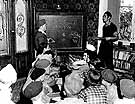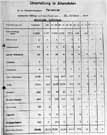
|
|
|

|

|

|

|
|
Click on an image to see a larger, more detailed picture.
|
|
|
|
|
| 1944: Desperate Acts |

|
pg. 566 |

|
|
|
|
| |
 By the fall of 1944 the German situation in Poland was crumbling rapidly, as Soviet forces advanced westward through the country toward Germany. And so the Nazis, who had enjoyed absolute mastery over Poland's residents not long before, now found themselves fighting a defensive war with a foregone conclusion. The horror, of course, is that this turn of events came too late to prevent the extermination of three million of Poland's 3.3 million Jews. Here, Polish fighters armed with submachine guns take aim at Nazi troops at Praga, a Warsaw suburb.
By the fall of 1944 the German situation in Poland was crumbling rapidly, as Soviet forces advanced westward through the country toward Germany. And so the Nazis, who had enjoyed absolute mastery over Poland's residents not long before, now found themselves fighting a defensive war with a foregone conclusion. The horror, of course, is that this turn of events came too late to prevent the extermination of three million of Poland's 3.3 million Jews. Here, Polish fighters armed with submachine guns take aim at Nazi troops at Praga, a Warsaw suburb.
Photo: Corbis-Bettmann
|
 A Jewish Brigade soldier teaches children Hebrew at the Rinshonim hachshara (agricultural training farm) in Bari, Italy, near the Adriatic Sea. The first of the training farms in Italy, Bari and those that followed sought to prepare refugees and survivors for a new future in Palestine. Reaching Italy in November 1944, the soldiers of the Brigade would take part in the final Allied offensive the following spring.
A Jewish Brigade soldier teaches children Hebrew at the Rinshonim hachshara (agricultural training farm) in Bari, Italy, near the Adriatic Sea. The first of the training farms in Italy, Bari and those that followed sought to prepare refugees and survivors for a new future in Palestine. Reaching Italy in November 1944, the soldiers of the Brigade would take part in the final Allied offensive the following spring.
Photo: Beth Hatefutsoth
|
 Natzweiler-Struthof was located in the Alsace region of France. Physically notable for stone and slate quarries, as well as subterranean factories built by inmates, Natzweiler was a concentration camp at which prisoners were worked to death. The camp's activities were expansive enough, in fact, to support numerous satellite camps; the whole complex exploited at least 20,000 people. The document seen here was found at Natzweiler in the autumn of 1944. Ledger-style, it subdivides male prisoners by age and type, and shows a complex mix: socialists, priests, criminals, Gypsies, POWs, anarchists, foreign civil workers, Spaniards, Jehovah's Witnesses, homosexuals, soldiers, "Aryans," and, inevitably, Jews.
Natzweiler-Struthof was located in the Alsace region of France. Physically notable for stone and slate quarries, as well as subterranean factories built by inmates, Natzweiler was a concentration camp at which prisoners were worked to death. The camp's activities were expansive enough, in fact, to support numerous satellite camps; the whole complex exploited at least 20,000 people. The document seen here was found at Natzweiler in the autumn of 1944. Ledger-style, it subdivides male prisoners by age and type, and shows a complex mix: socialists, priests, criminals, Gypsies, POWs, anarchists, foreign civil workers, Spaniards, Jehovah's Witnesses, homosexuals, soldiers, "Aryans," and, inevitably, Jews.
Photo: National Archives / United States Holocaust Memorial Museum Photo Archive
|
|

|

|

|

|
 October 17, 1944: SS functionary Adolf Eichmann returns to Budapest, Hungary, to secure 50,000 healthy Jews, who will be marched to Germany for forced labor; See October 20, 1944.
October 17, 1944: SS functionary Adolf Eichmann returns to Budapest, Hungary, to secure 50,000 healthy Jews, who will be marched to Germany for forced labor; See October 20, 1944.
|
 October 17, 1944: Dr. Josef Mengele supervises further gas-chamber selections of inmates at Auschwitz.
October 17, 1944: Dr. Josef Mengele supervises further gas-chamber selections of inmates at Auschwitz.
|
 October 18, 1944: Seven hundred Plaszów, Poland, camp deportees are sent from the Gross-Rosen, Germany, camp to Brünnlitz in the Sudetenland. Oskar Schindler, owner of a newly opened munitions factory in Brünnlitz, persuades the SS to give him all 700 Jews for use as workers. Schindler also makes arrangements to have 300 Jewish women transferred from Auschwitz to his factory; See January 21-29, 1945.
October 18, 1944: Seven hundred Plaszów, Poland, camp deportees are sent from the Gross-Rosen, Germany, camp to Brünnlitz in the Sudetenland. Oskar Schindler, owner of a newly opened munitions factory in Brünnlitz, persuades the SS to give him all 700 Jews for use as workers. Schindler also makes arrangements to have 300 Jewish women transferred from Auschwitz to his factory; See January 21-29, 1945.
|
|
|
|
|
| 1944: Desperate Acts |

|
pg. 566 |

|
|
The Holocaust Chronicle
© 2009 Publications International, Ltd.
|
|
